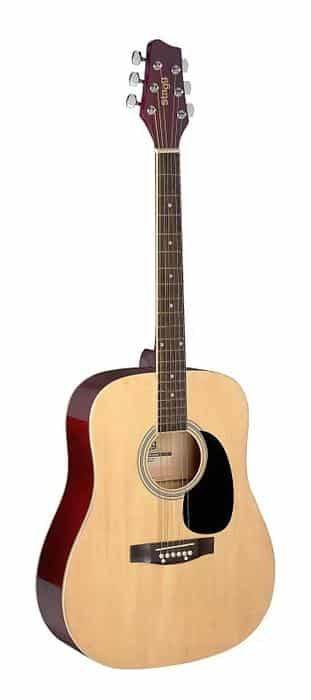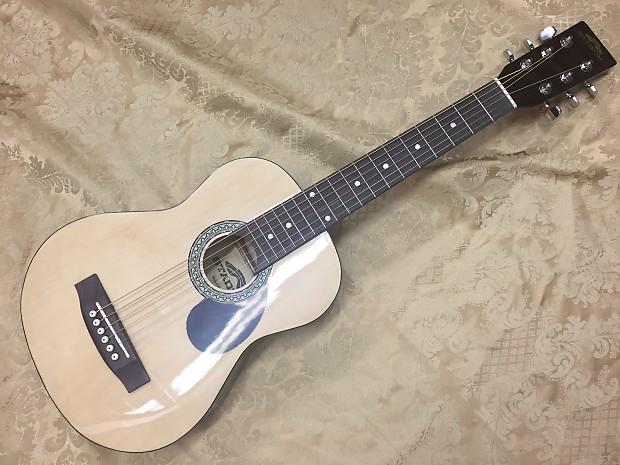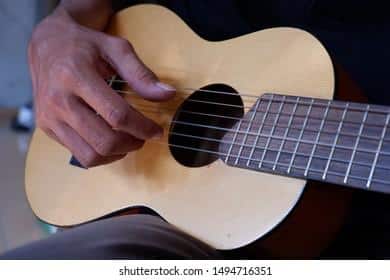Imagine a guitar that’s not only convenient to carry but also resonates with a depth of sound that belies its size. Now picture this benefiting a child embarking on a musical journey or a traveling musician needing a compact companion. You’ve just envisioned a 1/2 size, or mini guitar. However, the full scope of this guitar’s advantages has yet to be unveiled – that awaits you further down this page.
Tucking into more than twenty years of hands-on experience with instrument design and construction, I’ve cultivated a particular fondness for these pint-sized powerhouses. Their unique blend of convenience and rich tonality has consistently surprised and impressed me.
Contrary to popular belief, a 1/2 size guitar isn’t just a toy. It’s a fully qualified musical instrument, compact yet filled with potential. But don’t just take my word for this bold claim – let’s determine its truth together as we delve deeper into the fascinating world of 1/2 size guitars.
Whether you’re a parent pondering the appropriate instrument for your budding musician child, a travel-friendly guitar faithful, or simply curious, this comprehensive guide will be your encyclopedia. Together, let’s unravel the mysteries, comparisons, and top recommendations for 1/2 size guitars and their reliable influence in the music industry.
Understanding 1/2 Size Guitars
Design and Structure

Continuing from our journey to understand the intricate world of 1/2 size guitars, let’s delve into the design and structural details of this unique class of instruments. From the decades of experience I’ve gained designing and building guitars, I have come to appreciate the remarkable features of a short scale guitar.
Primarily, a 1/2 size guitar, also referred to as a junior size guitar, is substantially more compact, owing to its reduced body size and shorter neck length. This structural adaptation lends these guitars a distinct sound, characterized by a higher tone and a decreased emphasis on the bass range. The more diminutive form contributes not only to this unique tonality, but also enhances the portability and playability for specific groups of players, especially the younger ones and individuals with smaller hands.
Notably, the average total length of a half size guitar is usually around 34 inches, with the scale length — from the nut to the saddle — being approximately 20.5 inches. This is significantly shorter than a standard size guitar, hence the name ‘short scale guitar’.
Also, most of these guitars, particularly 1/2 classical guitars, are designed with nylon strings, as opposed to the steel strings usually found on their full-size counterparts. This is an essential factor in crafting their characteristic light, mellow sound and providing a softer touch for the players.
The process of creating these smaller instruments involves detailed craftsmanship to ensure quality isn’t compromised by size. Each facet, from frets to soundboard, needs careful consideration during design and construction to ensure these instruments maintain their musical integrity. While small in size, 1/2 size guitars carry sophisticated nuances that enrich their role in the guitar family.
The design and structure of a 1/2 size guitar may bear a closer resemblance to its larger counterparts than one might initially anticipate. Yet, its distinctive features, highlighted by its scaled dimension and choice of string material, set it apart and present it as a stand-alone class of guitars with specific virtues inhering in its nature and design.
Next up, we’ll get a closer look at the features and specs of these guitars and see how they align with their unique structure and appeal to different audiences.
Features and Specs

After exploring the understanding and importance of 1/2 size guitars, let’s delve into the meat of the matter – the features and specs. Many of my students have started their guitar journeys with beginner acoustic guitars . Their attributes and details are vital and can significantly impact one’s learning experience.
A beginner acoustic guitar, especially a 1/2 size, typically features a smaller body size, making it perfect for smaller-sized players or children. The neck is also shorter, facilitating easier reach for beginner fingers. What strikes the most about these guitars is their portability which allows players to practice anywhere and at any time.
Most 1/2 size guitars, such as the popular nylon string guitar, have nylon strings, favored for their softer touch. This is a crucial detail since steel-stringed guitars might be too harsh on beginners’ fingers. Notably, nylon string guitars often produce a mellow, round sound, ideal for a variety of genres, particularly classical and folk music.
Besides, their fretboards are usually broad and flat, allowing a comfortable grip for beginners. The lighter weight makes this guitar easy to handle, increasing playing stamina. Overall, these unique features and specs make 1/2 size guitars a prime choice for beginners and young learners, enhancing their developmental guitar journey.
Moving forward, who should use a 1/2 size guitar? And what are the popular models? The answers to these will further elucidate the wide prospects of 1/2 size guitars. Rest assured, understanding and mastering these features and specs will be the first step towards achieving guitar proficiency.
Who Should Use a 1/2 Size Guitar?

Many mistakenly conclude that a 1/2 size guitar is confined to use only by the younger demographic, primarily beginners in their earliest stages. But my journey as a tutor, instructing children and an ever-roaming, passionate group of traveling musicians, has proven this theory quite wrong. Indeed, I’ve found 1/2 size guitars to be beneficial to a surprisingly diverse array of individuals. This isn’t merely a small guitar for kids; it’s an instrument of versatility and efficiency.
You might be surprised at the diversity of those who can benefit from a 1/2 size guitar! Yes, the initial, and quite common, group that utilizes these compact wonders are children. Typically, students under 10 years old, yet showing a budding interest in learning guitar find this miniature version extremely beneficial. The smaller-scale structure of the instrument allows for a more comfortable and less straining playing experience. Even for older kids graduating from a quarter-sized guitar, transitioning to a half-size serves as an excellent step-up before maneuvering around full-sized instruments.
However, it’s not just about learning guitar for kids. For the mature enthusiasts seeking a trusty companion while traveling, a 1/2 size guitar fits the bill perfectly. Whether you’re a touring musician seeking a reliable backup, or you’re a nomadic strummer looking for an instrument that’s easy to carry, this smaller guitar cuts down on both weight and space. The convenience it provides is unmatched, without compromising the pure, resonant output these guitars are known for.
In the same vein, if you’re an adult learner just starting your journey into the realm of music, a 1/2 size guitar will not intimidate you with its size and will provide a manageable learning curve, making your experience enjoyable from the get-go.
Still unsure? Look at it this way. Musicians are as diverse as the music they make. Factors such as age, physical comfort, travel necessities, and learning capabilities vary vastly, also establishing the kind of instrument that suits them best. In this broad spectrum, a 1/2 size guitar effortlessly finds its place.
Stepping beyond the borders of conventional understanding, it’s evident that a 1/2 size guitar can serve a plethora of musicians, not just our young learners. Its compact size, lightweight build, and quality sounds make it a favored choice across a range of ages and capabilities. As I have personally experienced, a 1/2 size guitar can be just as purposeful and rewarding as its full-sized counterparts. So, the next time you overlook this gem, think again. Its potential to serve you just might surprise you.
Popular 1/2 Size Guitar Models

Knowing which guitars to pick and why can be a challenge especially when it’s a 1/2 size guitar that’s being decided upon. Having been a guitar enthusiast for years, I’ve come across many models and found that some truly stand out in reputation and performance. Specifically, the Cordoba Protegé C1M and the Yamaha CGS102A have managed to win not just the market but also my heart.
Let me elaborate, why these models? Well, I’ve personally gotten my fingers strumming on both, allowing me an intimate engagement with their sound and feel. The Cordoba Protégé C1M exudes an exquisite robust tone. Its satin finish not only enhances the guitar’s overall aesthetics but also contributes to its uniquely bright and full-bodied resonance. As part of the Cordoba’s student line of guitars, the C1M models truly embody the perfect balance of quality, sound, and affordability making it a popular choice for novice and younger players.
Think guitars are all the same? Ever thought about why some models stand out in popularity? Let’s probe a bit further taking the example of the Yamaha CGS102A, another of my personal favorites. What I love about this model is its oblong shape coupled with its comfortably thin neck. This feature allows for easier playability, especially for growing hands. In terms of sound, this Yamaha model radiates a midrange focused sound signature that’s both crisp and vibrant. This guarantees it a top-notch position in performance, whether it’s a solo practice session or a forthcoming concert.
A common characteristic that I admire in both these models, the Cordoba Protegé C1M and the Yamaha CGS102A, is their durable construction. Both these models come with a dependable build, promising longevity and reliability. Owning a guitar isn’t an everyday event and having one that sticks around, enduring the incessant practice sessions and occasional beatings is a blessing. Trust me on this, as someone who’s seen his share of guitars come and go, these gems are built to last.
As we explore the world of half-sized guitars, remember picking the right one shouldn’t only be about brand or design. It’s about the unique blend of sound, quality, comfort, and, of course, personal preference. After all, a guitar is not just an instrument; it’s an extension of the player.
In the ensuing sections, we will elaborate more on the practicalities of choosing half sized guitars as compared with other instruments such as the Ukulele and the Guitalele. So, stay tuned and walk with me as we delve deeper into the fascinating world of half-sized guitars.
Comparing 1/2 Size Guitar with Other Instruments
With Ukulele

Transitioning from the broader topic of ‘Comparing 1/2 Size Guitar with Other Instruments’ let’s now hone in on the intriguing contrast of the ‘With Ukulele’ subsection. The comparison of a ukulele and a 1/2 size guitar is particularly intriguing to me, given their distinct yet oddly similar characteristics.
Ukulele vs. guitar, a friendly contest that I find engrossing. The similarities are indeed captivating. For instance, both instruments share a nearly identical design and structure, albeit different in scale and size. Both can generate a wide array of sounds, with their beautiful tonal range creating delightfully harmonious melodies.
Nonetheless, when you delve into the comparison, the differences are just as, if not more, compelling. The size and tonal distinctions between the ukulele and the 1/2 size guitar must be acknowledged. The ukulele, with its petite structure and light nylon strings, tends to produce higher pitches and a warmer tone. On the other hand, the 1/2 size guitar is larger, encompassing a broader tonal range and often produces a more resonant and fuller sound.
I’ve always believed these differences should not be viewed as advantageous or disadvantageous but rather as unique characteristics that make each instrument beautifully special in its own way. The choice, of course, boils down to personal preference and what fits better with your musical style and comfort.
On that note, let’s continue this fascinating exploration by comparing the 1/2 size guitar with the hybrid variant, the guitalele, in the next section. Bridging the gap between the ukulele and the guitar, this instrument will surely pique your interest as we continue our journey into the realms of these delightful musical instruments.
With Guitalele

Moving from the ukulele, I want to draw attention to the intriguing realm of the guitalele. As a passionate practitioner and researcher of various stringed instruments, I find the guitalele provides an interesting contrast to the 1/2 size guitar. Essentially, the guitalele is an amalgamation of the guitar and ukulele, possessing the compact size of a ukulele, while offering the six strings typically found on a standard guitar.
For players used to the 1/2 size guitar, they would notice a few key differences. While the guitalele’s fretboard is significantly smaller, it provides the convenience of portability without compromising on a full range of notes. Constructed with nylon strings, it diverges from the steel strings often found on 1/2 size guitars, resulting in a smoother, softer sound that balances the treble tones of a ukulele and the bass undertones of a guitar.
From my experiences and observations, I can conclude that the guitalele presents a delightful blend and a unique intermediate level of playability, making it a fascinating study within the bigger conversation of instrument comparison. While it can’t fully mimic the deeper and richer tones of a 1/2 size guitar, its unique attributes make it worth consideration for exploratory musicians.
Transitioning onwards, it’s not just more traditional instruments we’re comparing. There are a range of modern creations expanding our musical horizons, as we’ll explore next.
FAQs
What are 1/2 size guitars?
How are 1/2 size guitars used differently?
Can you compare 1/2 size guitars with other models?
What are some recommended 1/2 size guitars?
Conclusion
Are you ready to embark on this exciting journey into the world of 1/2 size guitars? Having examined the structure, features, comparisons and recommendations of these smaller guitars, I hope this valuable information will enable you to make an informed decision about whether a 1/2 size guitar is the right fit for you or your child. They’re more than just a small guitar for kids, they’re also a handy travel guitar thanks to their lightweight and compact size.
Half size guitars aren’t only designed for beginners or children – the quality of sound and comfortable playability makes these smaller guitars a desirable choice for musicians of all ages. Whether compared to a ukulele or guitalele, the 1/2 size guitar holds its own, providing a unique musical experience.
In conclusion, I’m excited to share my knowledge and passion for 1/2 size guitars. These instruments hold a special place in my heart and I believe they offer an accessible entry point into the world of music. I hope this guide helps you to see the value in these wonderful instruments and inspires you to explore their potential. Remember, the journey of mastering an instrument begins with the first strum!